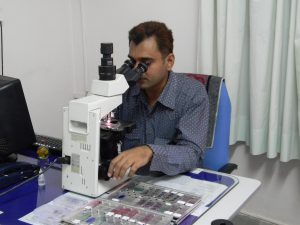For better or for worse the general public, what I will call the “patient public”, potential and existing consumers of healthcare services that may be delivered by pathologists and laboratories, do not know who we are.
 They do not know what a pathologist is or what pathology is. They don’t know if the lab in the hospital or the labs performing their tests in another facility are up to code on best clinical practices. They don’t know if the linearity is correct on the chemistry analyzer or if the immunohistochemical controls on their breast cancer slides are performing appropriately. Much like they do not know if the pharmacy or imaging departments have adequate quality control and quality assurance measures. They likely don’t know the radiologist but have a better idea of what he/she does.
They do not know what a pathologist is or what pathology is. They don’t know if the lab in the hospital or the labs performing their tests in another facility are up to code on best clinical practices. They don’t know if the linearity is correct on the chemistry analyzer or if the immunohistochemical controls on their breast cancer slides are performing appropriately. Much like they do not know if the pharmacy or imaging departments have adequate quality control and quality assurance measures. They likely don’t know the radiologist but have a better idea of what he/she does.
Patients, like consumers of other products and services, review quality measures, outcomes, number of complaints, etc… looking for best outcomes, shortest hospitalizations, decreased number of re-admissions, hospital acquired infections, etc…
For better or for worse, if they trust their clinician, patients trust the lab, radiology and pharmacy they refer them to. In some cases, the clinicians may not know the test is a “send out” to another lab altogether. How many times has a patient asked “Can you have the laboratory affiliated with XYZ do my blood work?” or “Can Dr. Jones read my colon biopsies?” Patients do not choose nor are they given the opportunity to pick their laboratories or pathologists as they may with other providers of their healthcare team. The clinicians may choose a particular pathologist to review a case but usually it is sent to the lab and they wait for the report.
For better or for worse, our interaction with patients is through their clinicians, their notes, consults and discussions about what they think, saw or the patient told them.
For better or for worse, as I recently read from In My Humble Opinion,
“Everyday I wake up to a schedule brimmed with purpose. The door of my office is a portal into the richness of the human experience. I become a thread in the tapestry of other’s lives. I bear witness to the joy and pain, laughter and heartache, and mundane daily routine.
I spend my days bouncing between art and science. Paid to be the wily detective, my brain stumbles on detail. Some cases are typical, quickly resolved with an adjustment here or there. Others are more enduring…The sick become healthy.
A familiarity grows out of the wisdom of experience. An acceptance of the limits of human knowledge. Self acceptance soon follows…I help people solve problems”
But we remain largely nameless and faceless to the patient. “Behind the scenes”, a consultant to the clinician hidden from public view.
For better or for worse, it is a decision one has to make when choosing pathology, the lack of direct patient contact on a continual basis, which appeals to many, the science more than the art or directly witnessing the sick becoming healthy. We appreciate our roles as “M.D.s” as in medical detectives to help solve problems.
For better or for worse, when we publish results such as a high discordance among breast diagnoses, even among expert pathologists, it barely moves the needle among the patient public. There is little concern or outrage from patient advocacy groups simply because the patient public do not know what or where the pathologist is and the particulars with preventing errors in pathology.
For better or for worse, pathologists do their part to insure we regulate ourselves with appropriate quality programs and laboratory inspections to lessen the chance that uncertainty occurs with a lab test or biopsy result, in the interests of patient safety and quality. And the patient public is served well.

































